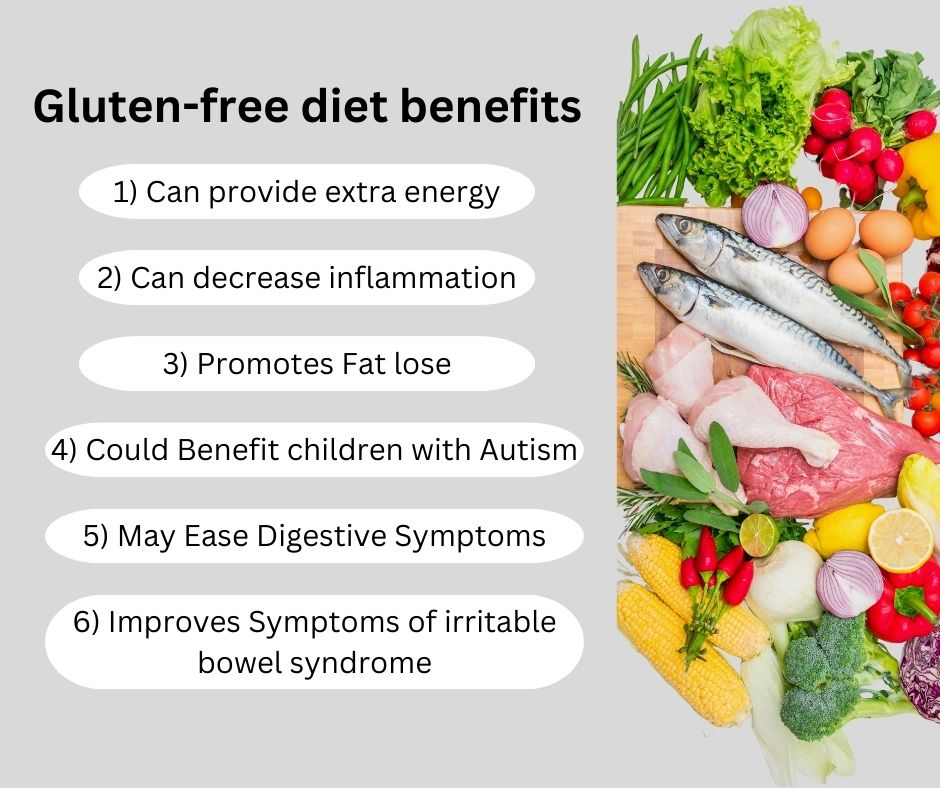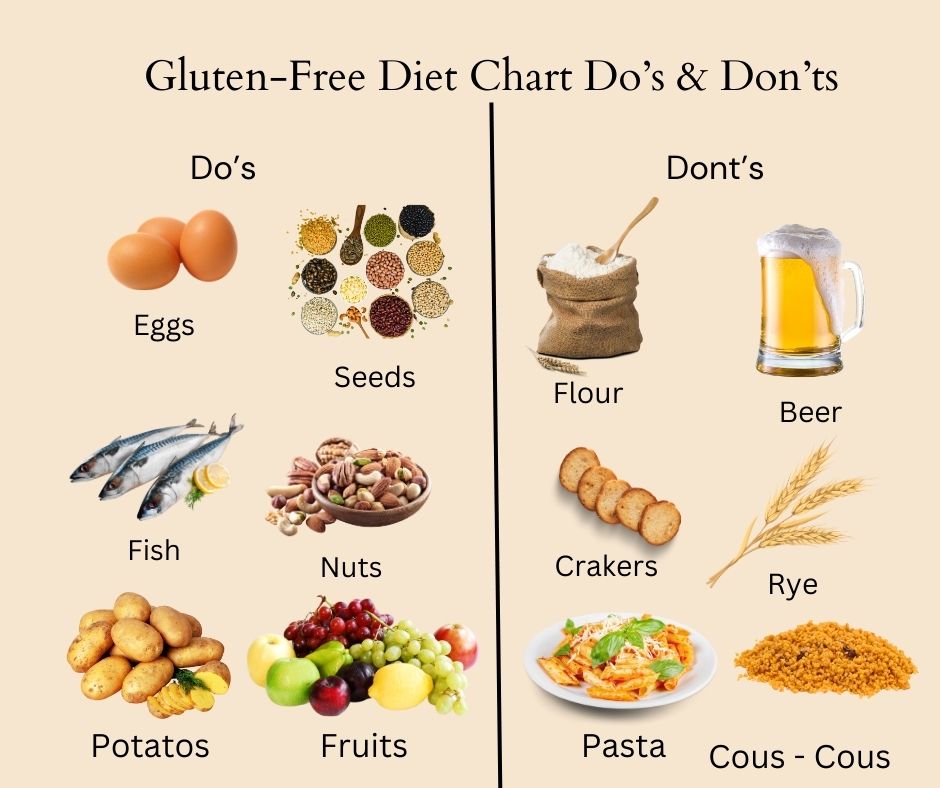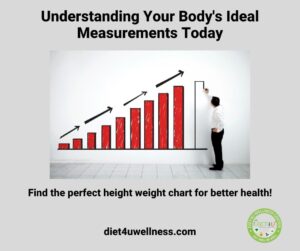
Balanced Gluten-Free Diet Chart for Optimal Health
Table of Contents
Gluten-Free Diet Chart: Gluten is a naturally occurring protein in some foods. Gluten may additionally be added to food while it’s being processed to give it a particular texture.
You may occasionally encounter gluten in meals you wouldn’t expect because it can be employed as a flavouring and binding agent.
After consuming gluten, a gluten intolerance may cause you to feel ill. You may have nausea, gas, or bloating. While gluten intolerance and celiac disease have many symptoms, they are not the same illness. Celiac disease is an autoimmune condition that harms the digestive system.
Stay tuned with this article to easily find out the answers to a load of questions your brain endures, like what a gluten-free diet is, how it helps celiac disease, whether gluten-free can lose weight on a gluten-free diet, what a gluten-free diet is for weight loss, and which foods to avoid on a gluten-free diet.
Gluten can be found in various foods and beverages, including pizza, pasta, cereal, baked goods, ice cream, soy sauce, pharmaceuticals, cosmetics, and dietary supplements.
Why does one need a gluten-free diet chart?
Many people have no trouble absorbing undigested gluten. However, in specific individuals, gluten may cause other unpleasant symptoms or a severe autoimmune reaction.
Celiac disease is an autoimmune reaction to gluten. Minor intestine damage can result from gluten. Even in the absence of celiac disease, some people nevertheless appear to get sick after consuming gluten-containing foods.
Now, the main question is, how does a gluten-free diet help celiac disease? The treatment for celiac disease involves cutting out gluten-containing items from your diet. By doing this, you can avoid intestinal lining damage and the symptoms that come with it, like stomach pain and diarrhea. If you have celiac disease, you have to give up all gluten for the rest of your life.
Is gluten unhealthy?
The idea that gluten is a bad food is widely misunderstood. For most people, gluten isn’t naturally harmful.
Since humans have been producing bread, we have been consuming gluten. For generations, people have been getting their protein, soluble fibre, and minerals from gluten-containing meals.
For healthy individuals whose bodies can handle it, gluten—especially the kind found in whole grains—is not harmful in and of itself. However, processed meals like potato chips and snack crackers frequently contain reduced whole grains, such as wheat.
The highly nutritious wheat plant is a little similar to these processed goods. They typically don’t contain whole grains but ingredients like starches and white rice flour.
Many people who follow a gluten-free diet chart yet consume processed foods still experience blood sugar fluctuations, weight gain, and other health problems. Therefore, the salt, sugar, and other chemicals in processed foods—rather than gluten—are to blame for their health problems.
Can you lose weight on a gluten-free diet chart?
Now, let us find out what a gluten-free diet is for weight loss. Individuals who follow a gluten-free diet chart frequently experience weight loss. This is typically due to their elimination of many processed food items and refined carbs that include gluten.
If you cut out gluten to lose weight, it’s crucial to exercise frequently, keep a healthy weight, and consume abundant good foods like fruits, vegetables, and lean proteins.
How can I start a gluten-free diet?
If you’re interested in attempting a gluten-free diet chart, speak with a physician or a trained dietitian. Who can help you develop a healthy eating plan that fits your particular dietary requirements.
If you have celiac disease you’re, here are some suggestions for dietary modifications:
- Examine packages for any warnings. A facility processing gluten products may also process a lot of non-gluten items.
- Separate your gluten-containing meal prep supplies from your regular kitchen utensils by separating dishes, pots, and pans.
- Carefully read ingredient labels to look for any indications of wheat. Gluten is also present in some artificial flavours and colours.
- Instead of using wheat flour for baking and cooking, try oats, buckwheat, quinoa, gluten-free flour, or grain flour substitutes.
Health benefits of a gluten-free diet chart

Better Digestive Health
Removing grains that contain gluten may help ease digestive discomfort, such as gas, bloating, and pain in the abdomen.
Elevated Vitality
Eating a gluten-free diet may give you more energy and less weariness.
Help with Weight Management
A gluten-free diet chart may be a helpful strategy for those looking to control their weight.
Decrease in Inflammation
The root cause of many long-term health problems is frequent inflammation. For those who are gluten intolerant, eating gluten-containing foods can exacerbate inflammation all over the body.
Stable blood sugar levels
For those at risk of developing diabetes or who currently have diabetes, a gluten-free diet chart may assist with stabilizing blood sugar levels.
Greater Skin Clarity
Gluten sensitivity has been connected to skin disorders such as dermatitis herpetiformis, eczema, and acne.
Enhanced Mental Acuity
After consuming gluten, some people claim to have cognitive impairment or brain fog.
Improved balance of the gut microbiome
The gut flora significantly impacts general health, digestive health, and the immune system.
Assistance with Autoimmune Disorders
Gluten intolerance is linked to several autoimmune diseases, such as Hashimoto’s thyroiditis and celiac disease. To learn more about the benefits of a gluten-free diet chart in India, join the health programmes offered by Diet4U Wellness under the guidance of Dr. Rukhsana Azhar.
Which foods should be avoided on a gluten-free diet chart?
“A gluten-free diet chart should exclude barley, rye, triticale, and wheat (including spelt, kamut, farro, and durum). Cereals, baked foods, pasta, and bread frequently contain these grains. Moreover, avoid processed foods like sauces, soups, and salad dressings, as they could include gluten that isn’t readily apparent because they’re flavourings or thickening agents. To avoid cross-contamination, always read labels for items that may contain gluten. Switch to naturally gluten-free foods like corn, rice, and quinoa as well as fruits, vegetables, lean proteins, and other whole grains.” Says Dt. Rukhsana Azhar form Diet4U Wellness.

Gluten-free Foods List
Grains
A balanced diet must include whole grains, such as bread, pasta, and crackers. Healthy carbs, such as whole grains, give you the energy you need to get through the day.
However, many grains are naturally gluten-free, and there is good news for rice lovers wondering: Is rice gluten-free? Because all rice is gluten-free when consumed in its natural state. One of the most well-liked gluten-free grains among people living with celiac disease is rice. Instead of wheat flour, rice flour is used to make many packaged gluten-free products. Rice is gluten-free by nature; however, occasionally, it might not be.
Fruits & Vegetables Without Gluten
Incorporating fresh, complete fruits and vegetables into a gluten-free diet chart is crucial as they are inherently gluten-free. Produce is an excellent source of antioxidants, vitamins, and minerals.
However, you’ll need to look for hidden gluten when you look at packaged produce instead of just the produce section. Several processed fruit and vegetable varieties may contain gluten-containing substances in their preparation or preservation.
Vegetables frozen or fresh without sauce are gluten-free but double-check the ingredient lists on the packaging. Choose vegetables canned with water or natural juice (which is usually the better option).
Gluten-Free Proteins
Most protein sources, including plant and animal proteins, are inherently gluten-free. However, gluten can infiltrate meat and vegetable proteins through extra substances like taste enhancers, fillers, and rubs. This list allows you to choose which proteins to include in a gluten-free diet chart.
Spices, Condiments, and Sauces Without Gluten
One of the easiest places for gluten to sneak in unnoticed is sauces. Gluten-containing substances can be employed as thickeners, stabilizers, or taste enhancers in several common condiments.
Gluten is present in many sauces and marinades because wheat flour is frequently used as a thickener. These are some less apparent gluten sources that you should be aware of. Watch for cross-contamination whenever you bring these objects inside your house.
For example, if you wish to maintain the gluten-free status of a mustard-spread knife, it should not be re-dipped into the mustard jar.
Sweets and Desserts Without Gluten
Many pastries and sweets contain gluten-containing substances, such as wheat flour. As more businesses produce gluten-free versions of their goods, keep in mind that while they won’t always be healthier than conventional treats, gluten-free candies will prevent a negative reaction if you have gluten sensitivity.
Beverages and Drinks Without Gluten
There are many gluten-free drinks available, but you must be cautious to ensure you don’t unintentionally sip anything that has gluten. Naturally, gluten-free water is the healthiest beverage for staying hydrated. Verify the contents of every prepared beverage, as some blends and variations may include gluten.
What are the signals that your diet free of gluten is effective?
Your symptoms of celiac disease should improve as soon as you switch to a gluten-free diet chart. Most people gauge the effectiveness of their gluten-free diet by changes in their symptoms. Here are six indicators to be aware of.
Reduced gastrointestinal symptoms
Reducing your gluten intake can help with stomach issues. You might observe that your feces are less runny and firmer. Also, you may experience less pain and bloating in your abdomen.
Increased energy
When you follow a gluten-free diet chart, your small intestine begins to mend itself. Your small intestine can absorb minerals from your diet without continuous attack.
Stable body mass
Due to the small intestine’s inability to absorb nutrition, some people living with celiac disease find it challenging to maintain a healthy weight. However, maintaining a constant body weight becomes easier when you follow a gluten-free diet chart, as your body can better utilize energy.
Increased density of bones
Osteoporosis and low bone density are possible side effects for some celiac patients. Elevate your bone density with a gluten-free diet chart.
Enhanced Mood
Psychological disorders can arise in people with celiac disease. Diets free of gluten appear to help alleviate symptoms of depression. The signs of ADHD can also occur in children with celiac disease.
A clearer skin
Dermatitis herpetiformis and other skin disorders can result from celiac disease. A gluten-free diet can help people’s itchy, bumpy rash improve or even disappear completely.
FAQs Related to Gluten-free Diet Chart
Q. How may celiac disease patients benefit from a gluten-free diet chart?
Eliminating gluten from the diet aids celiac disease by preventing immune system responses that harm the small intestine’s lining.
Q. Is rice free of gluten?
Indeed, rice may be safely incorporated into a gluten-free diet chart because it is inherently gluten-free.
Q. Is a gluten-free diet conducive to weight loss?
By concentrating on healthy foods while excluding processed gluten-free goods that are heavy in calories and sugar, you can lose weight while following a gluten-free diet chart.
Q. What is a weight-loss diet free of gluten?
Eating organically gluten-free foods such as fruits, vegetables, lean meats, and gluten-free grains is part of a diet free of gluten for weight loss, but processed gluten-free goods should be avoided.
Q. Which foods must a gluten-free diet include?
Avert products that don’t say gluten-free and contain wheat, barley, rye, or oats. Bread, pasta, grain products, and several processed meals fall under this category.
Q. What is a diet free of gluten?
A gluten-free diet prohibits all foods containing gluten, a protein present in wheat, barley, & rye. However, it does include eating organically gluten-free foods and items with specific labels.
Q. What advantages does a gluten-free diet offer?
A gluten-free diet has several advantages, such as better digestion, more energy, decreased inflammation, and alleviating celiac disease and gluten sensitivity symptoms.
Q. How can I make a gluten-free diet chart?
Creating a gluten-free diet chart involves making a list of naturally gluten-free items and organizing meals around them. Dt. Rukhsana Azhar of Diet4U Wellness can provide a customized gluten-free eating plan.
Q. What gluten-free dishes are popular in India?
In India, rice, millet (bajra), sorghum (jowar), maize (makki), and pulses are common gluten-free foods. Nuts, dairy, fresh fruit, and veggies are all inherently gluten-free.
Q. Where can I discover additional details regarding a diet devoid of gluten?
See Dr. Rukhsana Azhar of Diet4U Wellness for thorough advice on a gluten-free diet. She can offer individualized meal plans tailored to your needs.

Hello My Name is Dt. Ruksana Azhar and I am a certified dietician and providing online & offline services for Weight Management, PCOS/PCOD Management, Diabetes Management , etc. I have 12+ years of experience in the Apollo Hospital Delhi , Max Super Specialty Hospital Delhi, Lilavati Hospital Mumbai and VLCC healthcare Mumbai. I loves to write healthcare and lifestyle related blog. My favorite part of being a doctor is the opportunity to directly improve the health and wellbeing of my patients and to develop professional and personal relationships with them.



